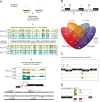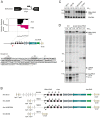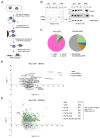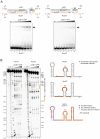The primary transcriptome of Neisseria meningitidis and its interaction with the RNA chaperone Hfq
- PMID: 28334889
- PMCID: PMC5449619
- DOI: 10.1093/nar/gkx168
The primary transcriptome of Neisseria meningitidis and its interaction with the RNA chaperone Hfq
Abstract
Neisseria meningitidis is a human commensal that can also cause life-threatening meningitis and septicemia. Despite growing evidence for RNA-based regulation in meningococci, their transcriptome structure and output of regulatory small RNAs (sRNAs) are incompletely understood. Using dRNA-seq, we have mapped at single-nucleotide resolution the primary transcriptome of N. meningitidis strain 8013. Annotation of 1625 transcriptional start sites defines transcription units for most protein-coding genes but also reveals a paucity of classical σ70-type promoters, suggesting the existence of activators that compensate for the lack of -35 consensus sequences in N. meningitidis. The transcriptome maps also reveal 65 candidate sRNAs, a third of which were validated by northern blot analysis. Immunoprecipitation with the RNA chaperone Hfq drafts an unexpectedly large post-transcriptional regulatory network in this organism, comprising 23 sRNAs and hundreds of potential mRNA targets. Based on this data, using a newly developed gfp reporter system we validate an Hfq-dependent mRNA repression of the putative colonization factor PrpB by the two trans-acting sRNAs RcoF1/2. Our genome-wide RNA compendium will allow for a better understanding of meningococcal transcriptome organization and riboregulation with implications for colonization of the human nasopharynx.
© The Author(s) 2017. Published by Oxford University Press on behalf of Nucleic Acids Research.
Figures








Similar articles
-
Investigating RNA-Protein Interactions in Neisseria meningitidis by RIP-Seq Analysis.Methods Mol Biol. 2019;1969:33-49. doi: 10.1007/978-1-4939-9202-7_3. Methods Mol Biol. 2019. PMID: 30877668
-
An atlas of Hfq-bound transcripts reveals 3' UTRs as a genomic reservoir of regulatory small RNAs.EMBO J. 2012 Oct 17;31(20):4005-19. doi: 10.1038/emboj.2012.229. Epub 2012 Aug 24. EMBO J. 2012. PMID: 22922465 Free PMC article.
-
A novel Hfq-dependent sRNA that is under FNR control and is synthesized in oxygen limitation in Neisseria meningitidis.Mol Microbiol. 2011 Apr;80(2):507-23. doi: 10.1111/j.1365-2958.2011.07592.x. Epub 2011 Mar 7. Mol Microbiol. 2011. PMID: 21338417
-
Impacts of Small RNAs and Their Chaperones on Bacterial Pathogenicity.Front Cell Infect Microbiol. 2021 Jul 12;11:604511. doi: 10.3389/fcimb.2021.604511. eCollection 2021. Front Cell Infect Microbiol. 2021. PMID: 34322396 Free PMC article. Review.
-
Contributions of the Hfq protein to translation regulation by small noncoding RNAs binding to the mRNA coding sequence.Acta Biochim Pol. 2016;63(4):701-707. doi: 10.18388/abp.2016_1362. Epub 2016 Nov 23. Acta Biochim Pol. 2016. PMID: 27878140 Review.
Cited by
-
Solution structure and RNA-binding of a minimal ProQ-homolog from Legionella pneumophila (Lpp1663).RNA. 2020 Dec;26(12):2031-2043. doi: 10.1261/rna.077354.120. Epub 2020 Sep 28. RNA. 2020. PMID: 32989045 Free PMC article.
-
Transcriptome architecture and regulation at environmental transitions in flavobacteria: the case of an important fish pathogen.ISME Commun. 2021 Jul 7;1(1):33. doi: 10.1038/s43705-021-00029-9. ISME Commun. 2021. PMID: 36739365 Free PMC article.
-
Structural basis for sequence-specific recognition of guide and target strands by the Archaeoglobus fulgidus Argonaute protein.Sci Rep. 2023 Apr 14;13(1):6123. doi: 10.1038/s41598-023-32600-w. Sci Rep. 2023. PMID: 37059709 Free PMC article.
-
RNase III-mediated processing of a trans-acting bacterial sRNA and its cis-encoded antagonist.Elife. 2021 Nov 29;10:e69064. doi: 10.7554/eLife.69064. Elife. 2021. PMID: 34843430 Free PMC article.
-
Bacterial RNA chaperones and chaperone-like riboregulators: behind the scenes of RNA-mediated regulation of cellular metabolism.RNA Biol. 2022;19(1):419-436. doi: 10.1080/15476286.2022.2048565. Epub 2021 Dec 31. RNA Biol. 2022. PMID: 35438047 Free PMC article.
References
-
- Henriques-Normark B., Normark S.. Commensal pathogens, with a focus on Streptococcus pneumoniae, and interactions with the human host. Exp. Cell Res. 2010; 316:1408–1414. - PubMed
-
- Stephens D.S., Greenwood B., Brandtzaeg P.. Epidemic meningitis, meningococcaemia, and Neisseria meningitidis. Lancet. 2007; 369:2196–2210. - PubMed
-
- Greenwood B. Manson lecture. Meningococcal meningitis in africa. Trans. R. Soc. Trop. Med. Hyg. 1999; 93:341–353. - PubMed
MeSH terms
Substances
LinkOut - more resources
Full Text Sources
Other Literature Sources
Molecular Biology Databases

